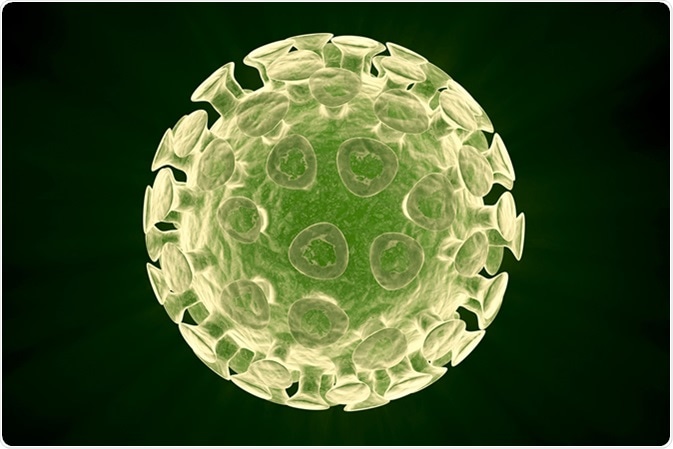Hepatitis C is a term which denotes inflammation of the liver as a result of infection by the hepatitis C virus. There are many agents which are capable of attacking the liver, resulting in cell death or damage. This in turn evokes an inflammatory response in the body to help fight these agents.
The body’s response may help kill the hepatitis C virus. An extremely strong reaction, or a sustained inflammatory response, may extensively damage the liver, resulting in a fatal outcome. On the other hand, a very weak reaction may not eliminate the virus, resulting in chronic infection and significant liver damage.

Hepatitis C virus, 3D illustration. Image Credit: Maryna Olyak / Shutterstock
Many individuals with hepatitis C are asymptomatic. They are not aware that they have an infection. However, they will probably experience some symptoms as the condition progresses, because of the increasing damage to the liver. For this reason, it is extremely important to diagnose hepatitis C infection in its early stages to minimize or avert potential serious complications.
Hepatitis C is an RNA virus. The virus’s genetic data is contained in a strand of RNA, which can be deciphered by the host cell's ribosomes. The virus has no specific requirements to replicate or sustain itself because it harnesses the cell's metabolic processes and reproduction capabilities for its own life cycle. The virus needs little RNA for encoding its core data. It contains fewer common characteristics, making it more difficult for the body’s immune system to track it, which may be one reason for the lack of symptoms in some cases.
Early stage symptoms
Only about 25% to 35% of those with hepatitis C will experience symptoms during the first half-year of infection. If symptoms and signs are to appear, they usually will do so a few weeks after onset of the virus. During this time period, the condition is called acute hepatitis C.
Symptoms of hepatitis C infection include:
- Elevated temperature at or greater than 100.4 F.
- Exhaustion.
- Little desire to consume food.
- Stomach cramps or pain.
- A sense of having an illness – feeling sick.
The problem with making a correct diagnosis is that some of these symptoms are not specific to hepatitis C.
Many of those with hepatitis C continue to be asymptomatic until the liver tissue becomes scarred, and cirrhosis sets in. Soft healthy tissue becomes hard fibrotic tissue in many parts of the liver. Yet, even at this point, no symptoms may appear. Eventually, the liver fails, at which point sudden and serious symptoms and signs appear. To combat this problem, high-risk population screening must be carried out extensively and thoroughly.
Late stage symptoms
Long term, or chronic, hepatitis C brings with it a variety of symptoms, some which may not even be noticeable, and some which can heavily influence the person’s quality of life. Moreover, the symptoms may disappear for a while, and then unexpectedly return.
Chronic hepatitis C sufferers will experience:
- Almost continuous exhaustion
- Muscle, joint, and stomach discomfort and pain
- Intermittent or continuous sickness
- Memory issues, including difficulty with being able to concentrate; finishing complicated mental functions, including mental arithmetic; and near-term memory issues
- Changes in mood
- Being anxious or depressed
- Dyspepsia
- Skin rash and itching
Untreated hepatitis C often leads to cirrhosis, which was described previously. Signs of cirrhosis can include blackish stools, jaundice, and extensive fluid collection in the legs. There is a growing risk of liver cell cancer over time.
References
Further Reading